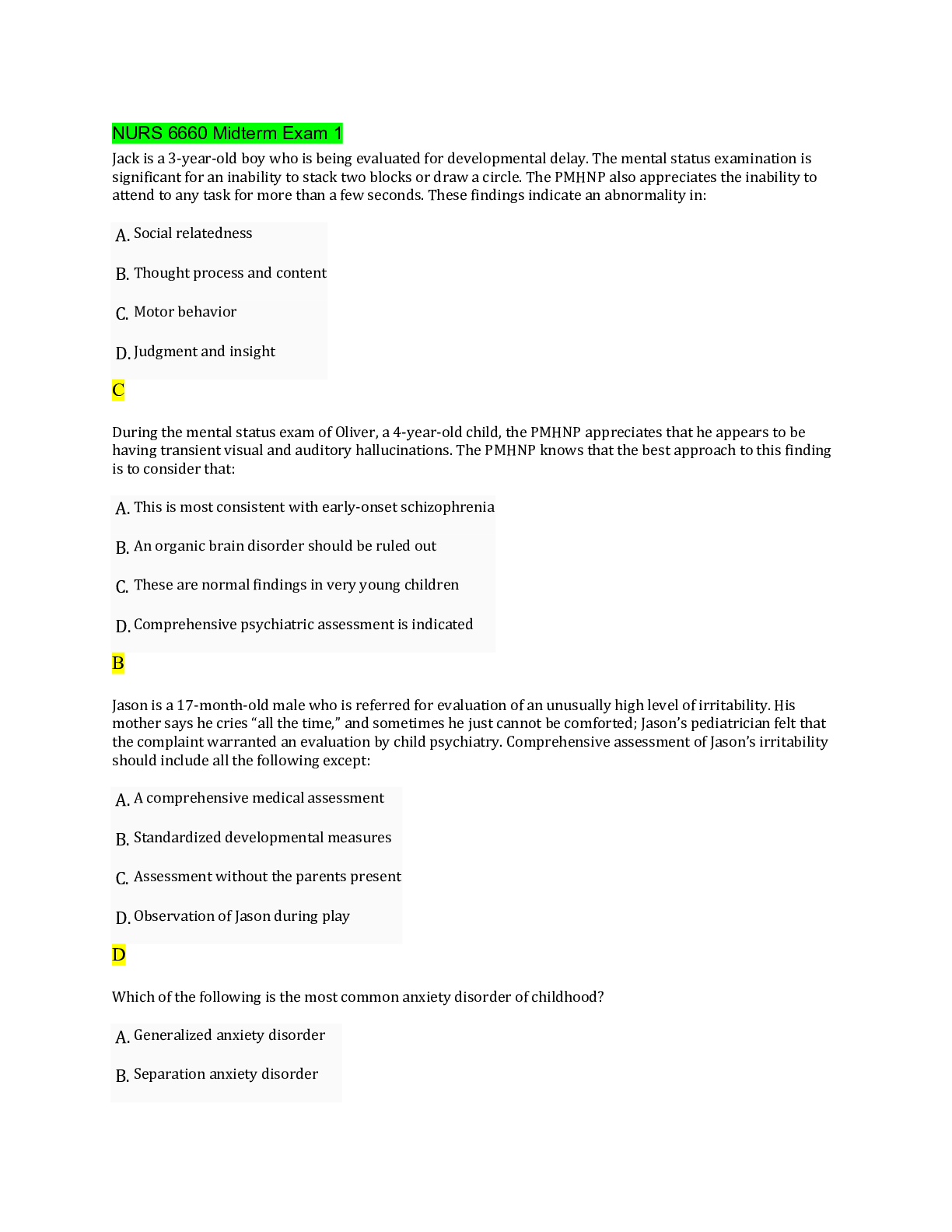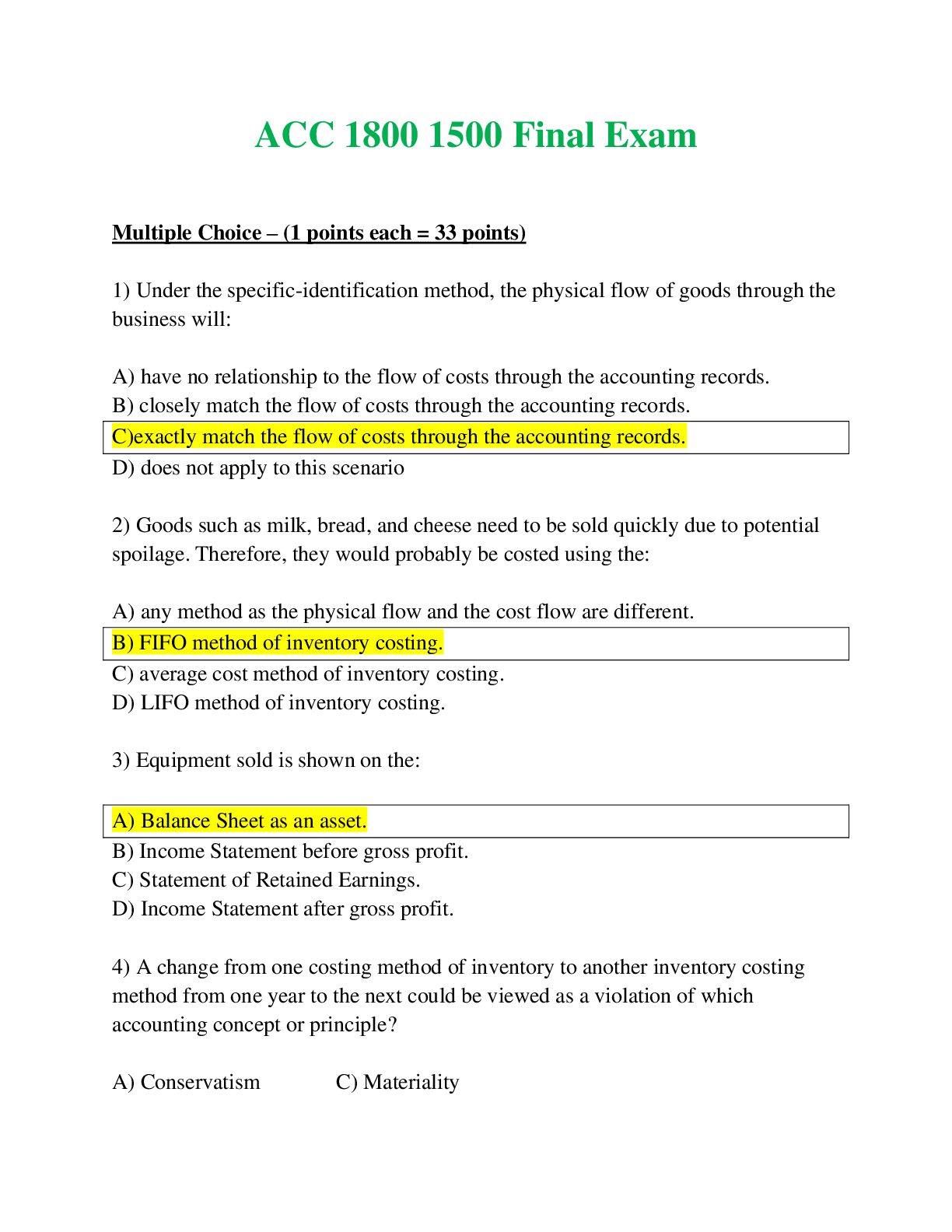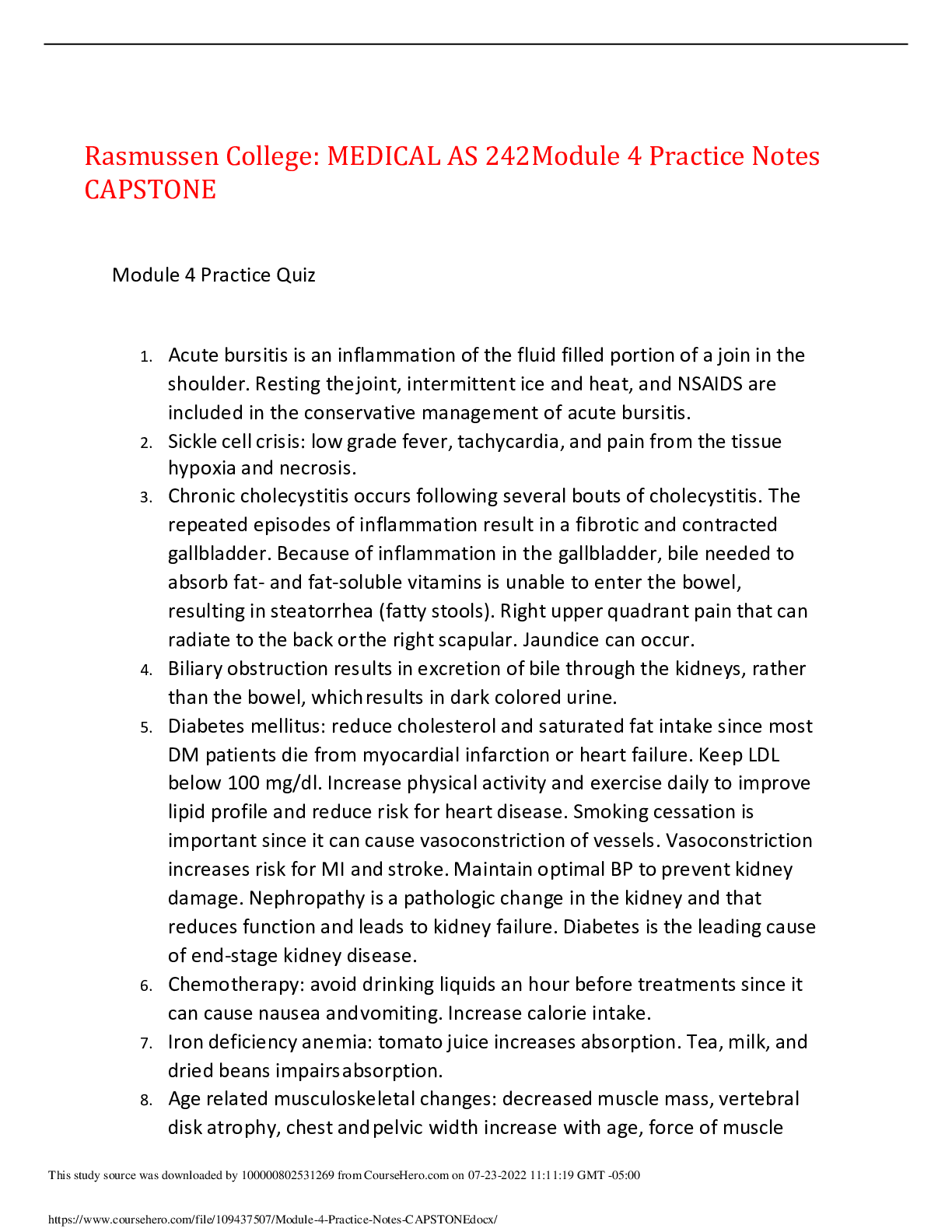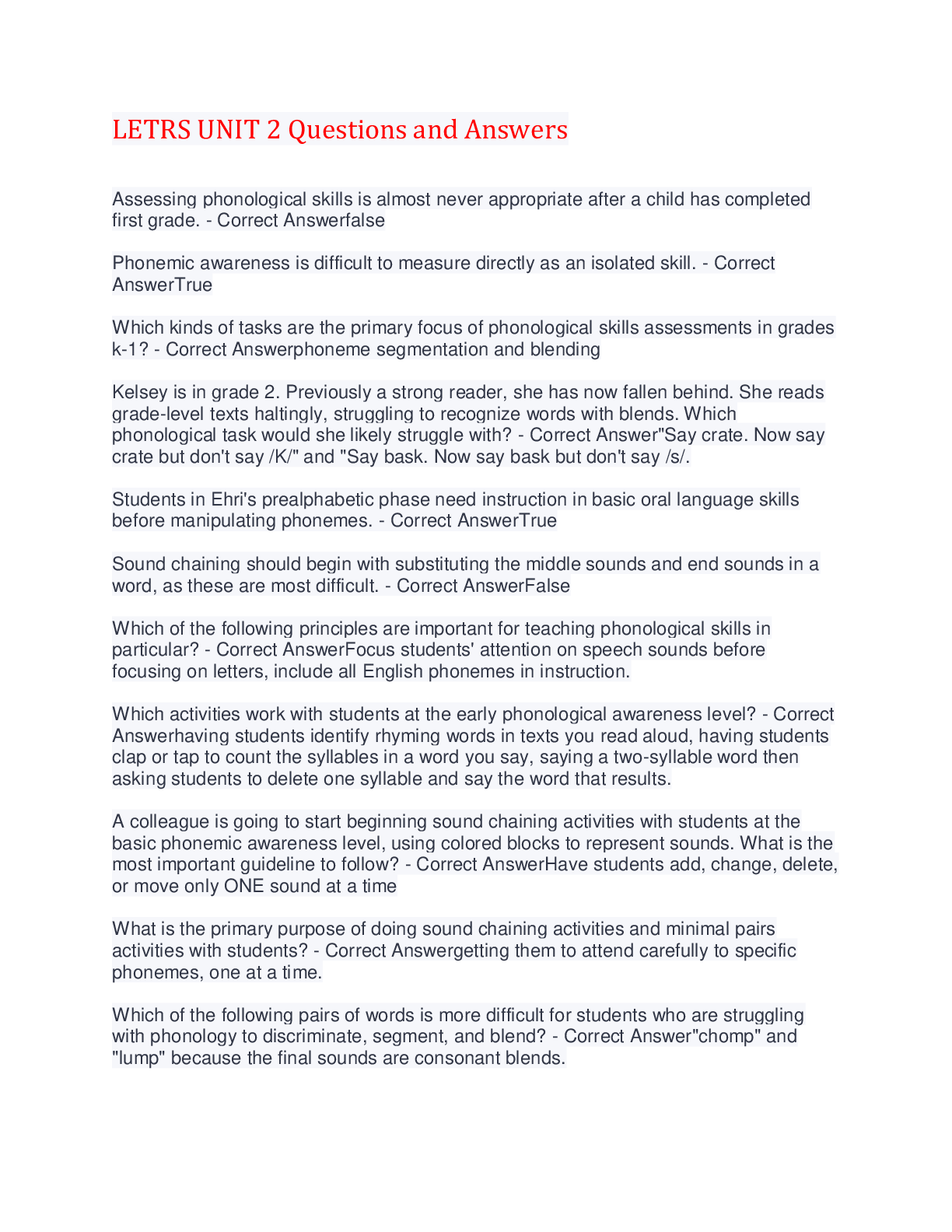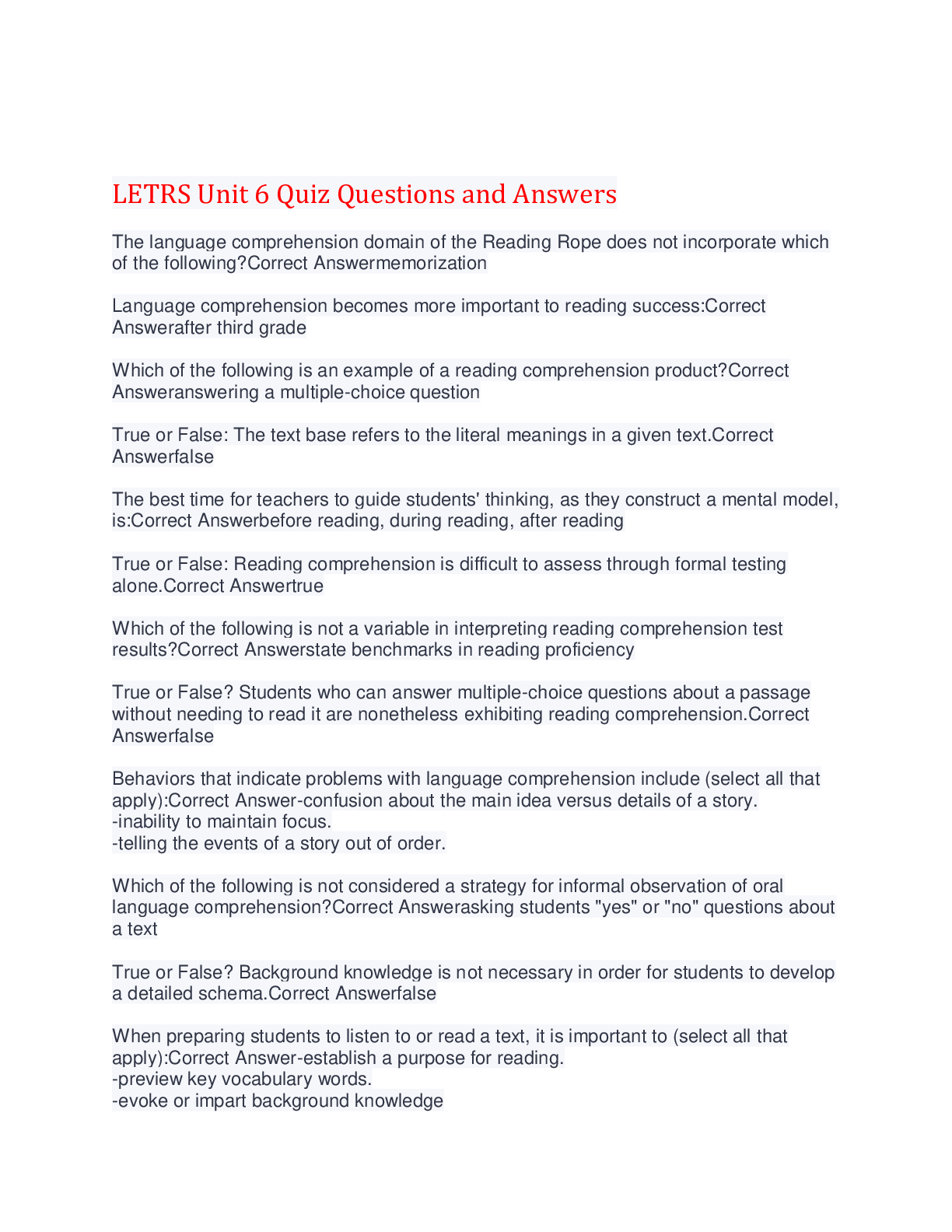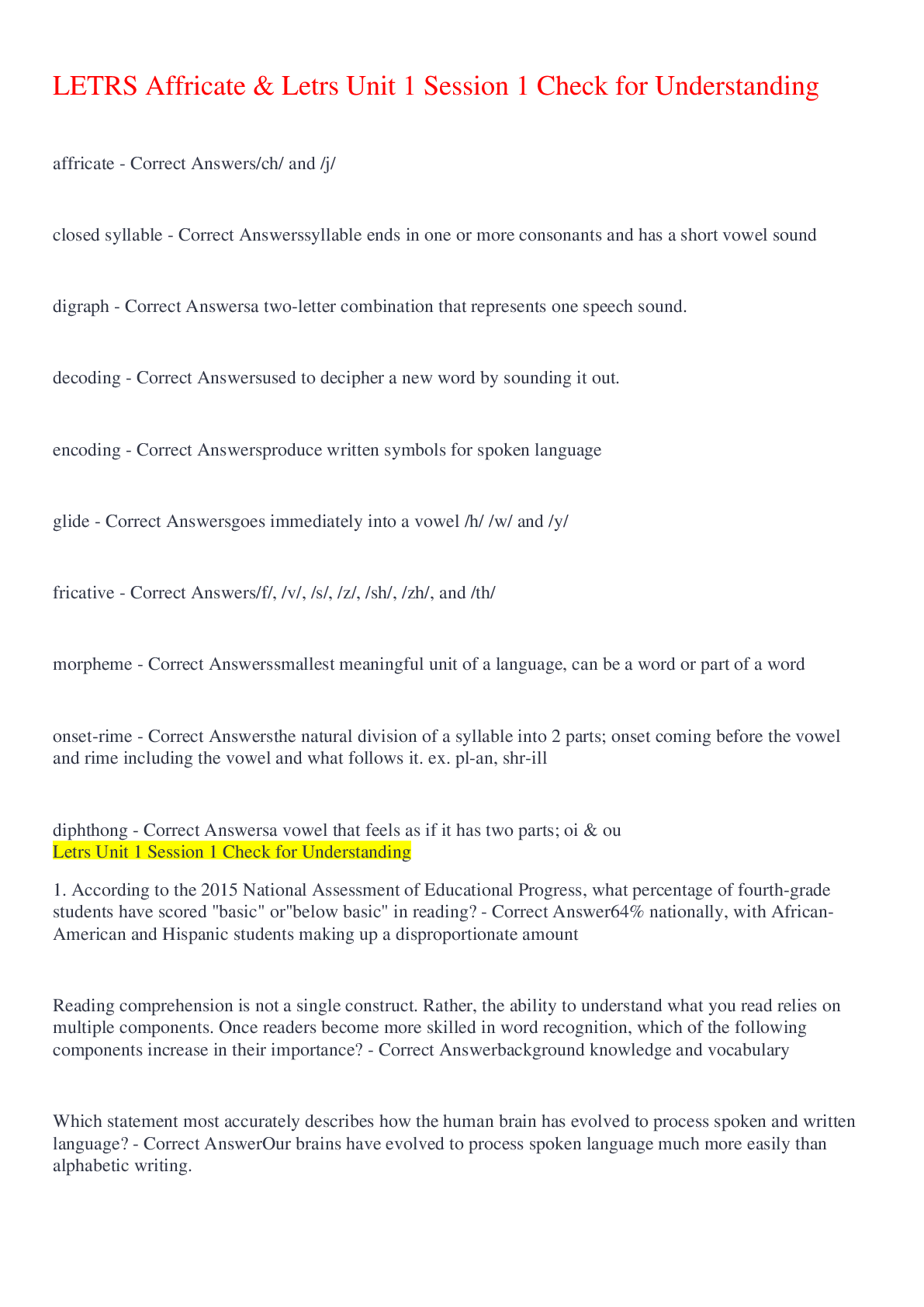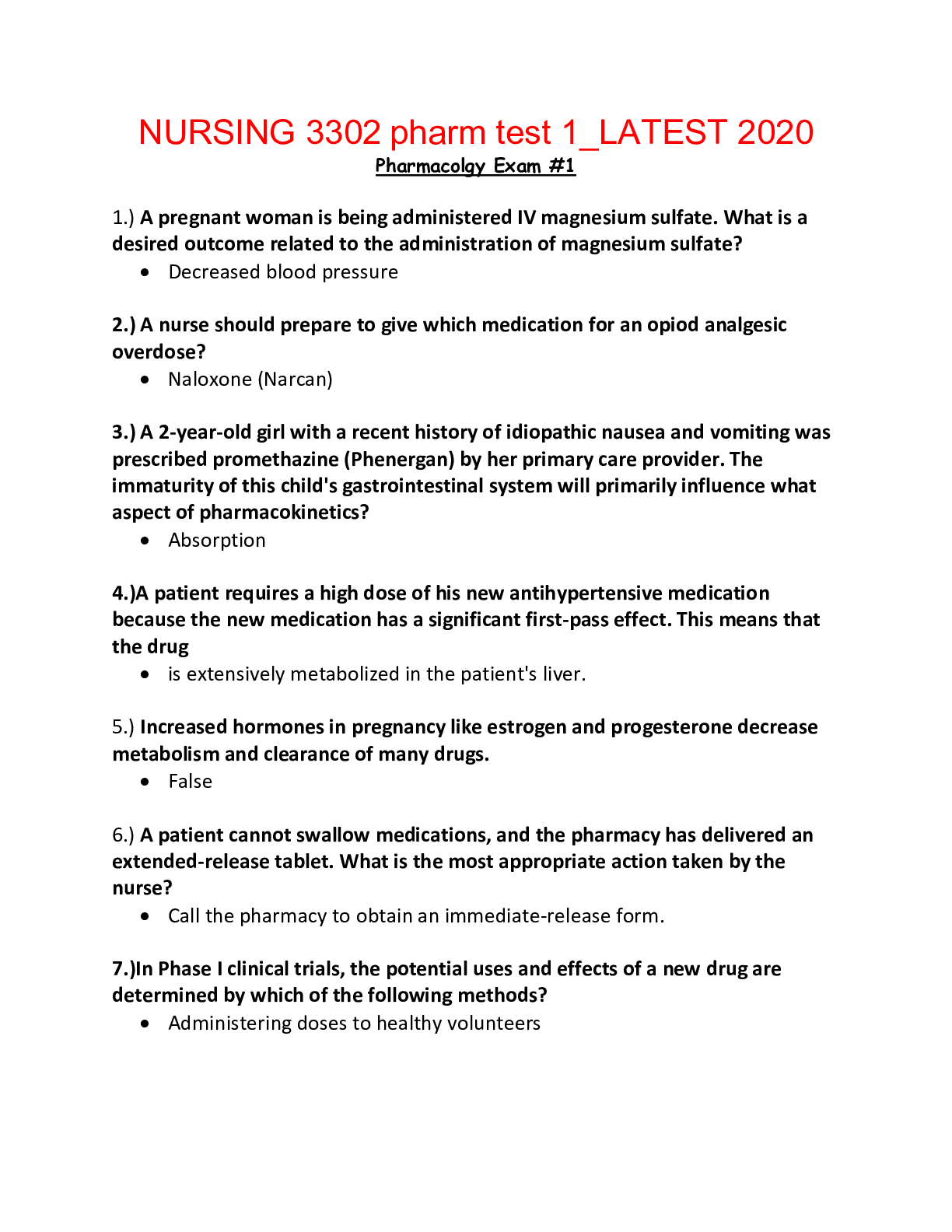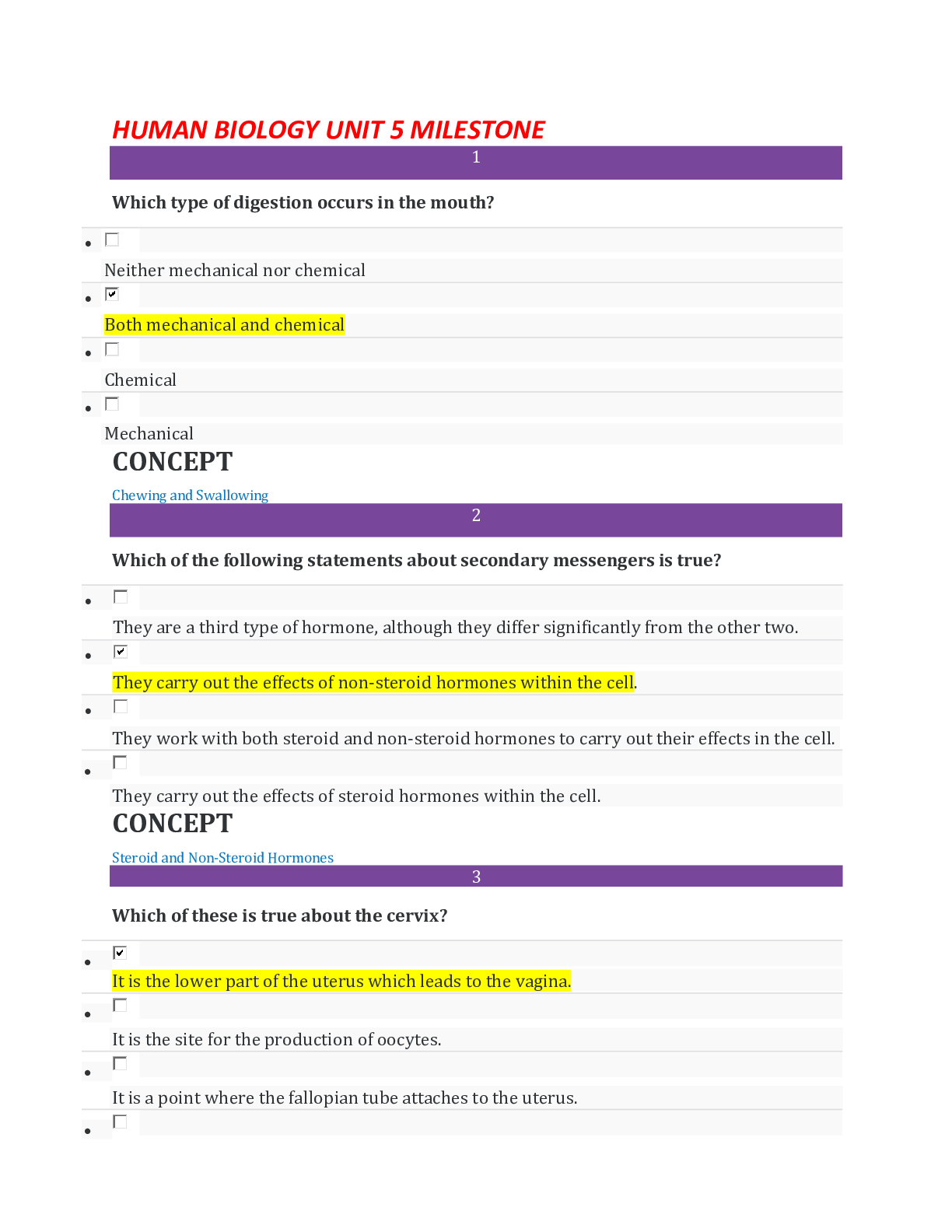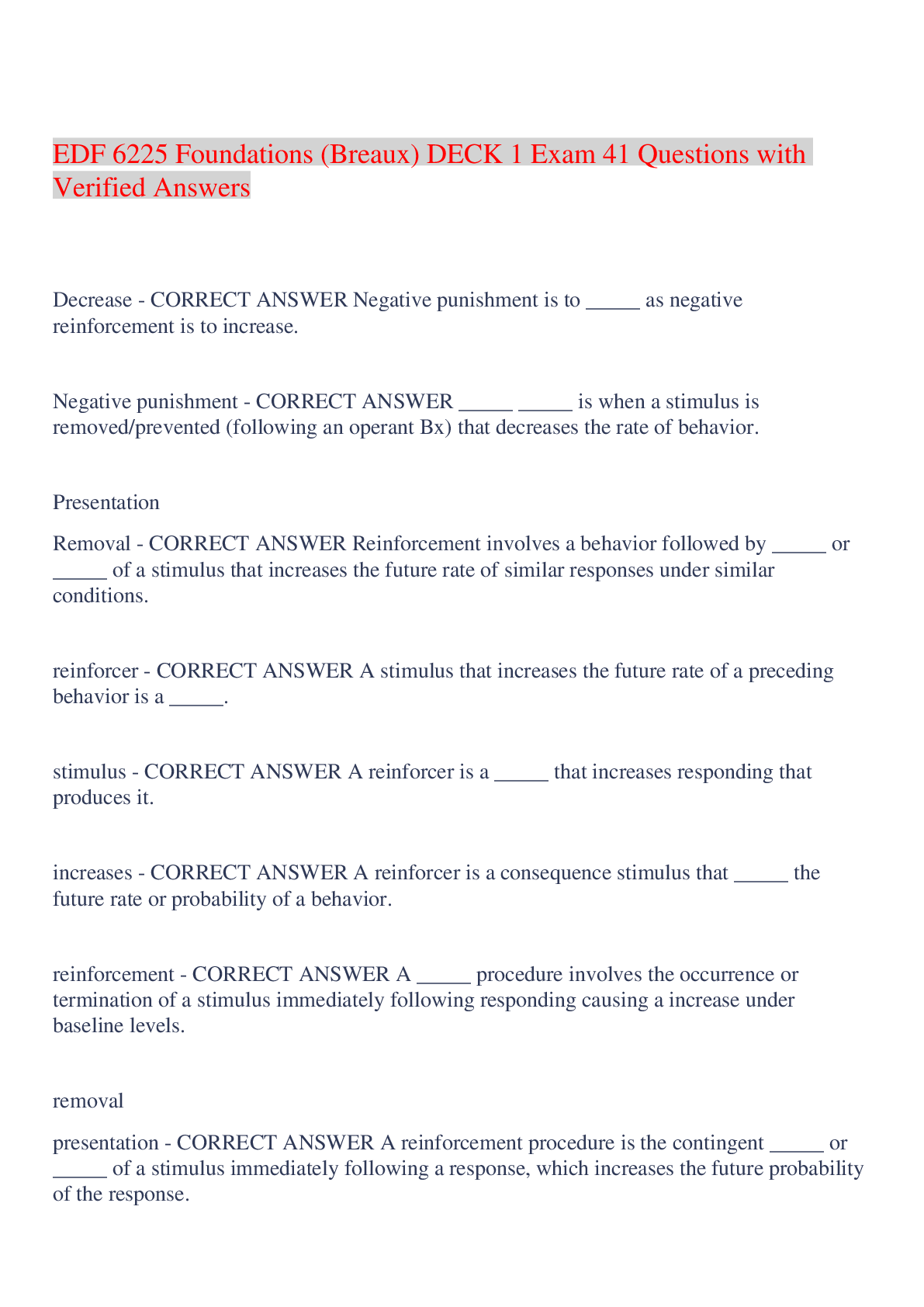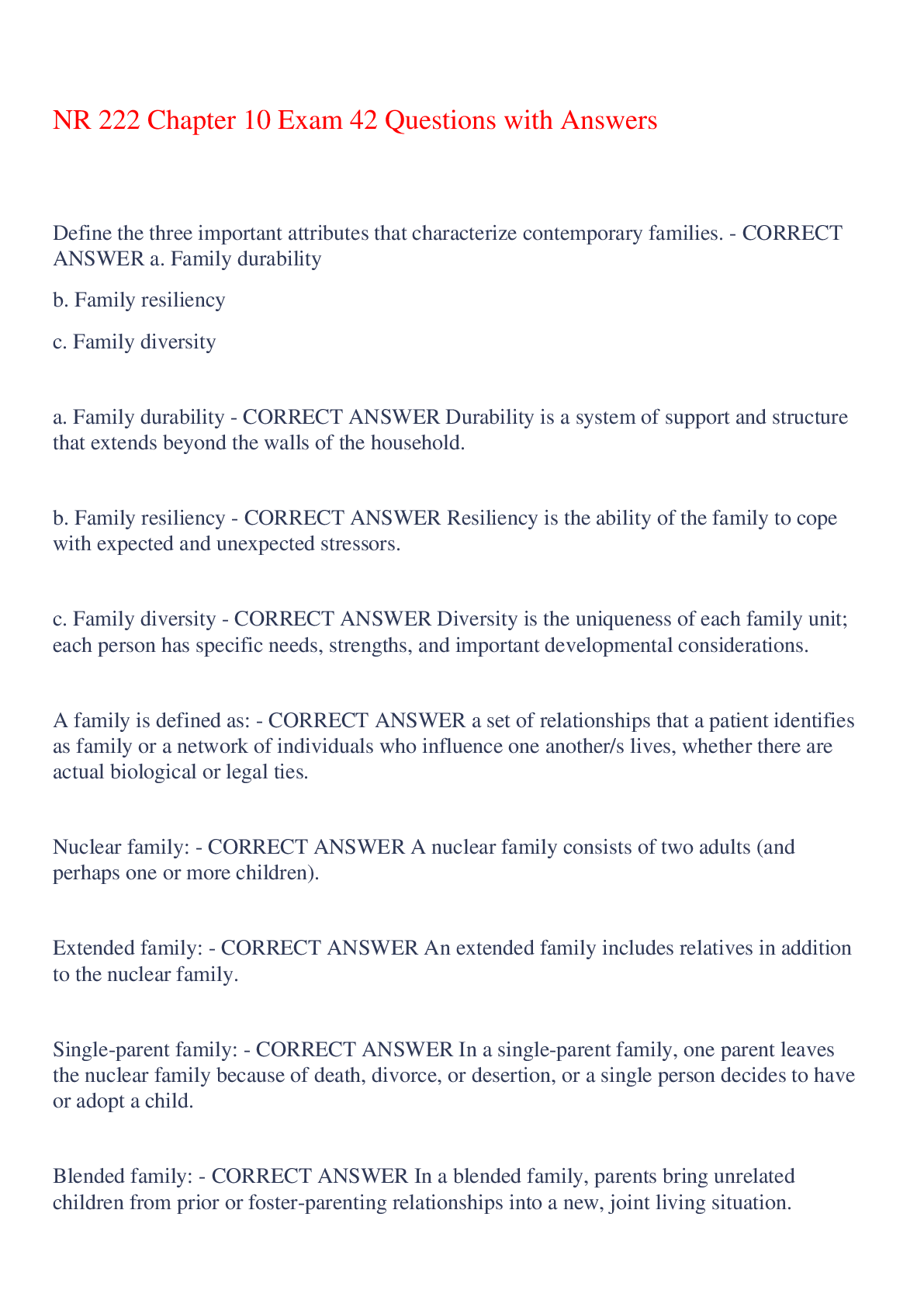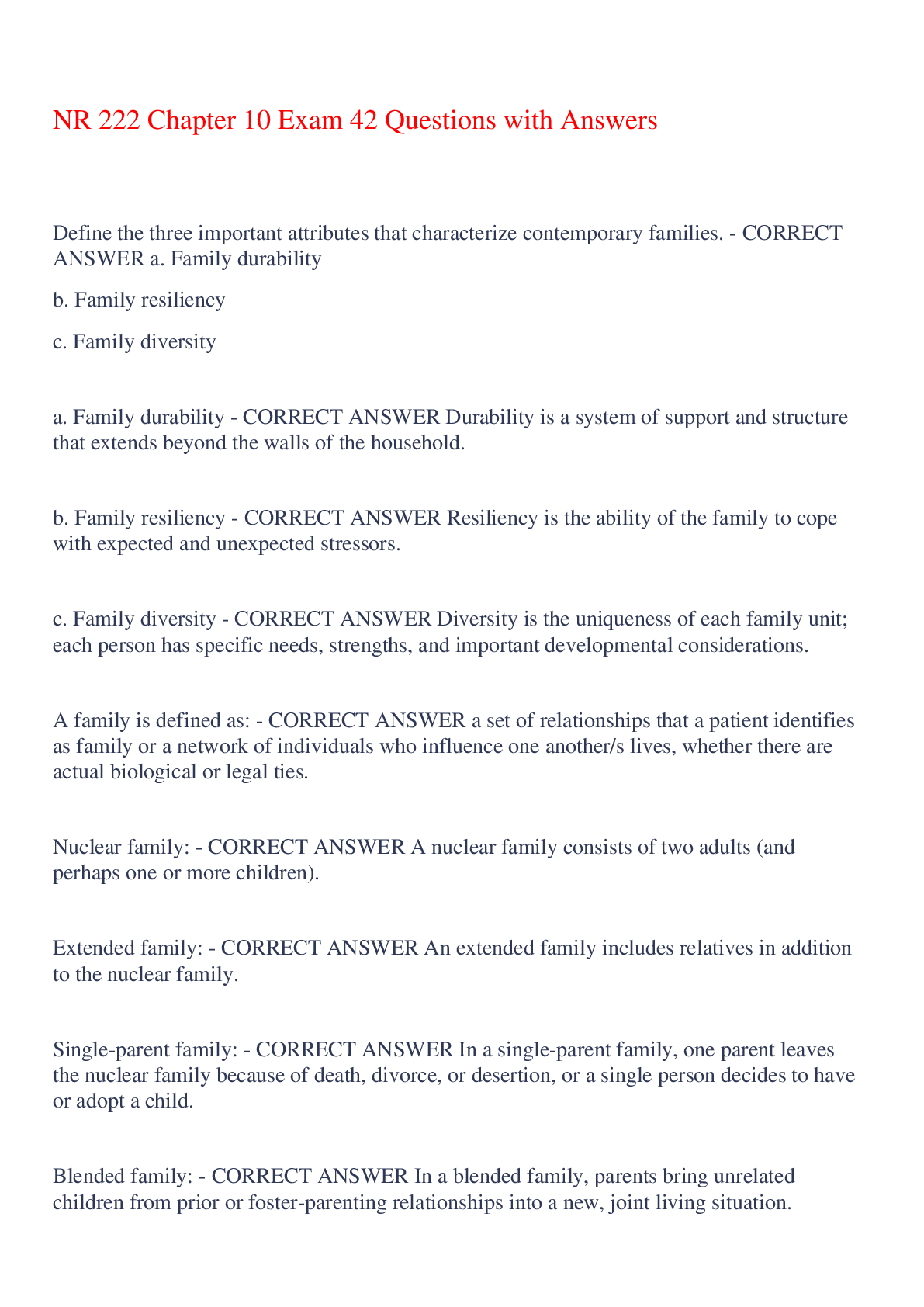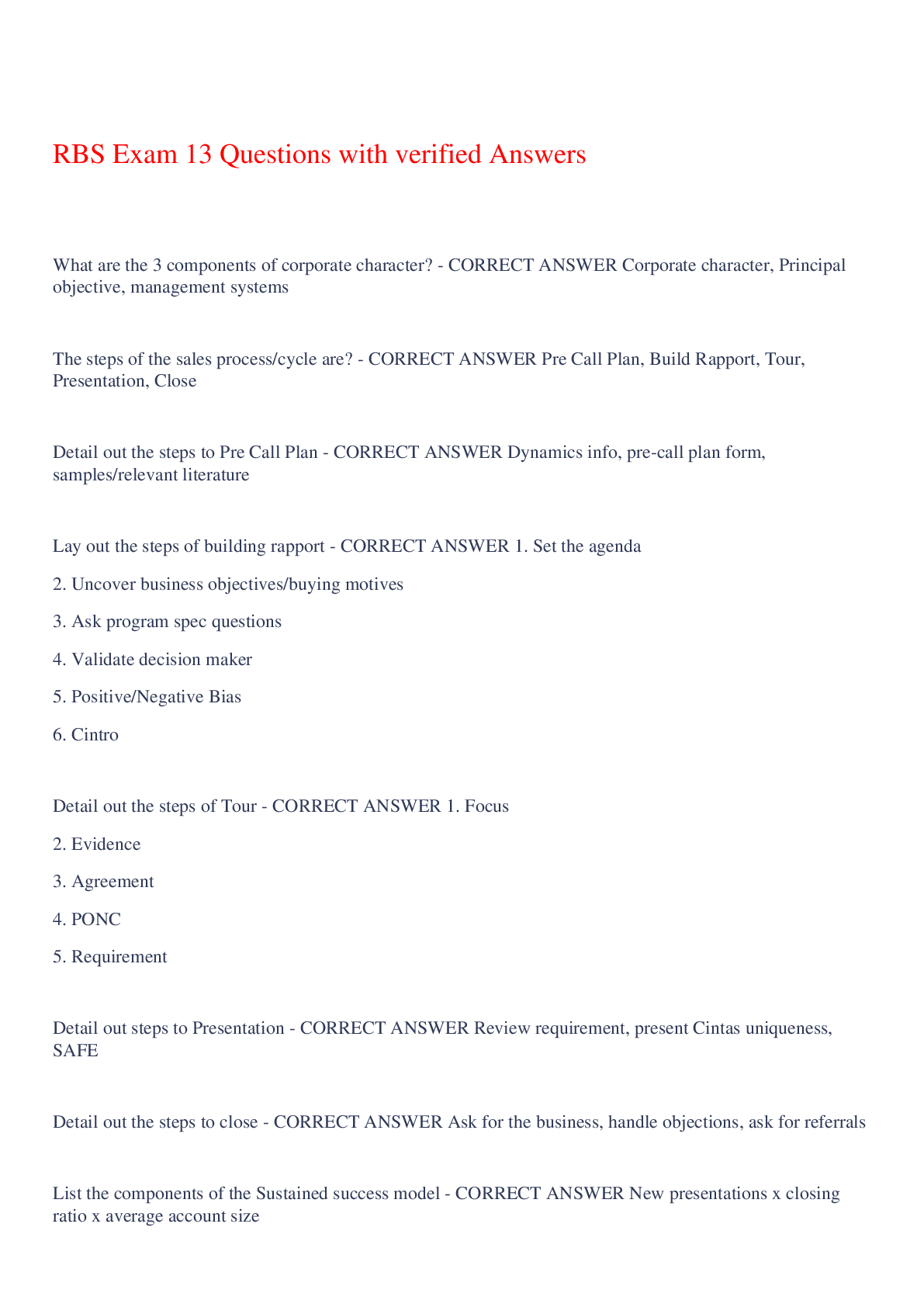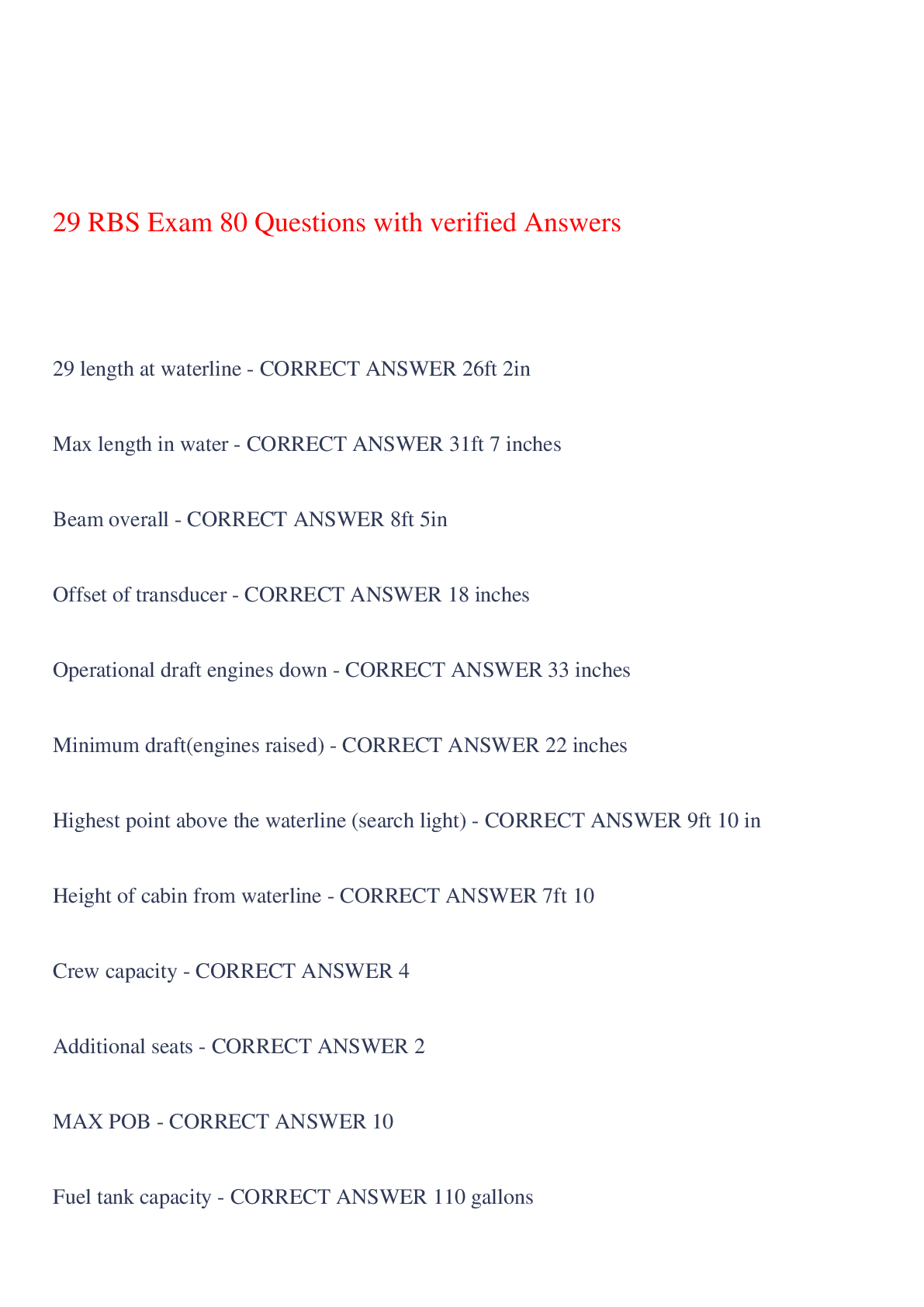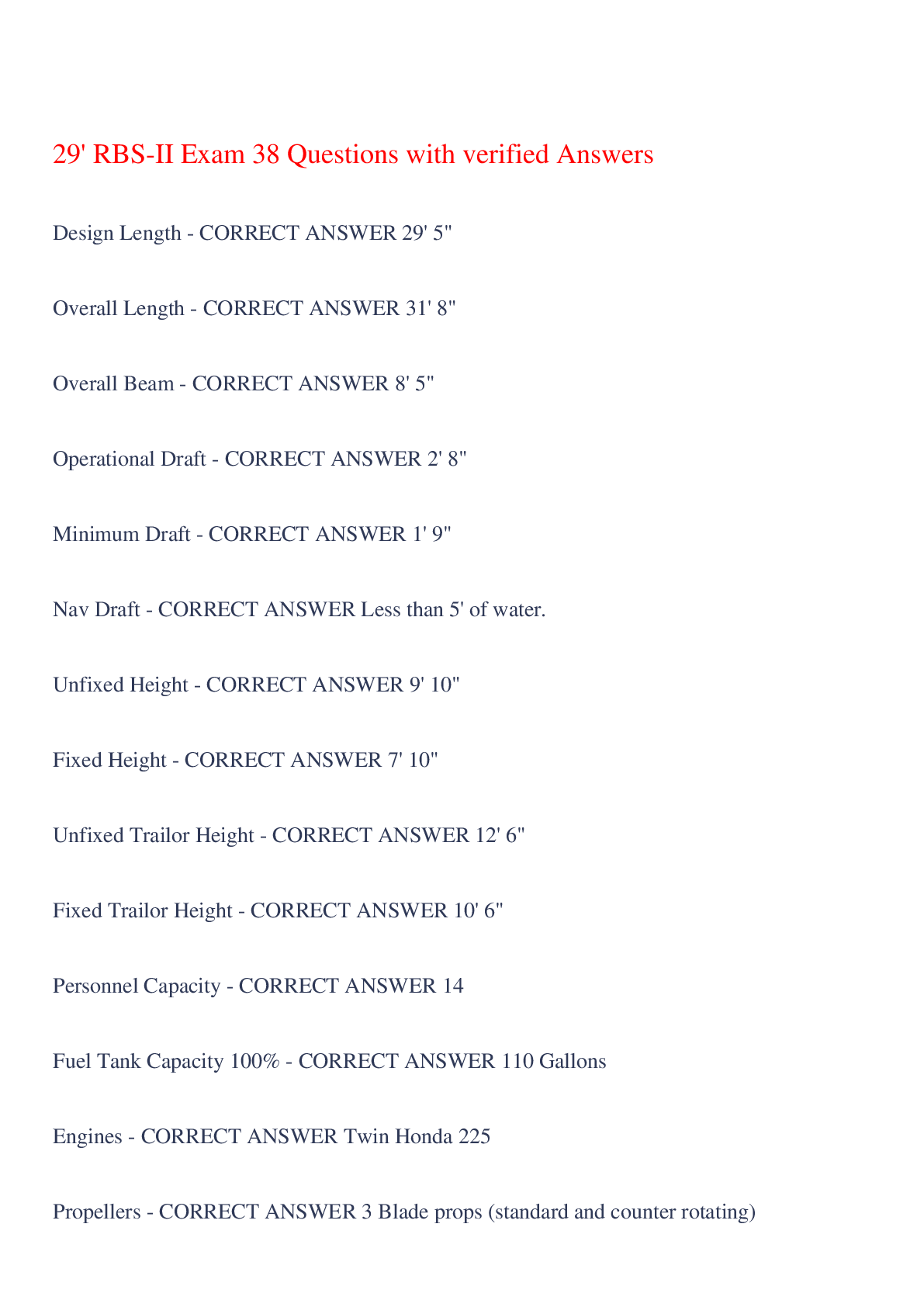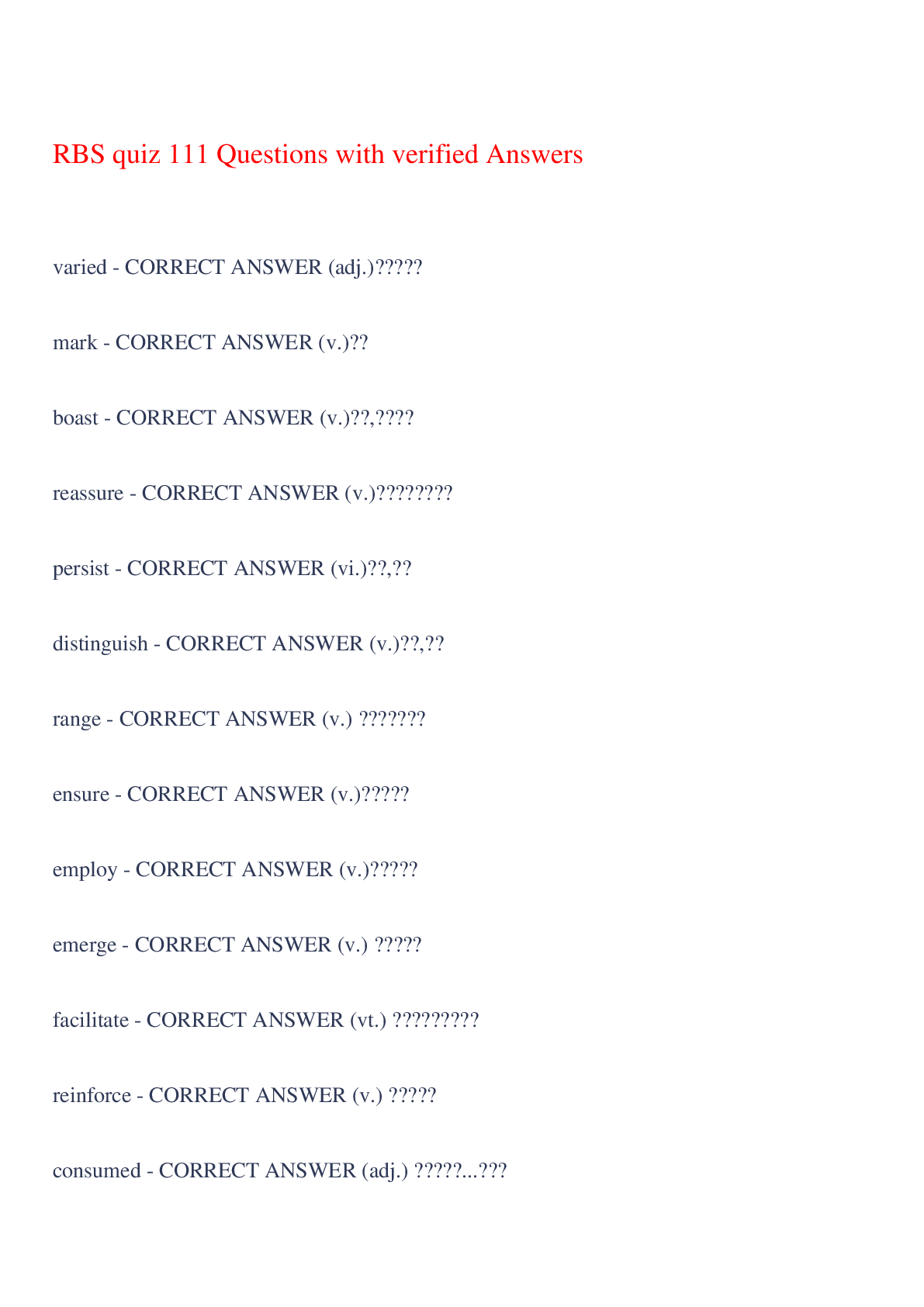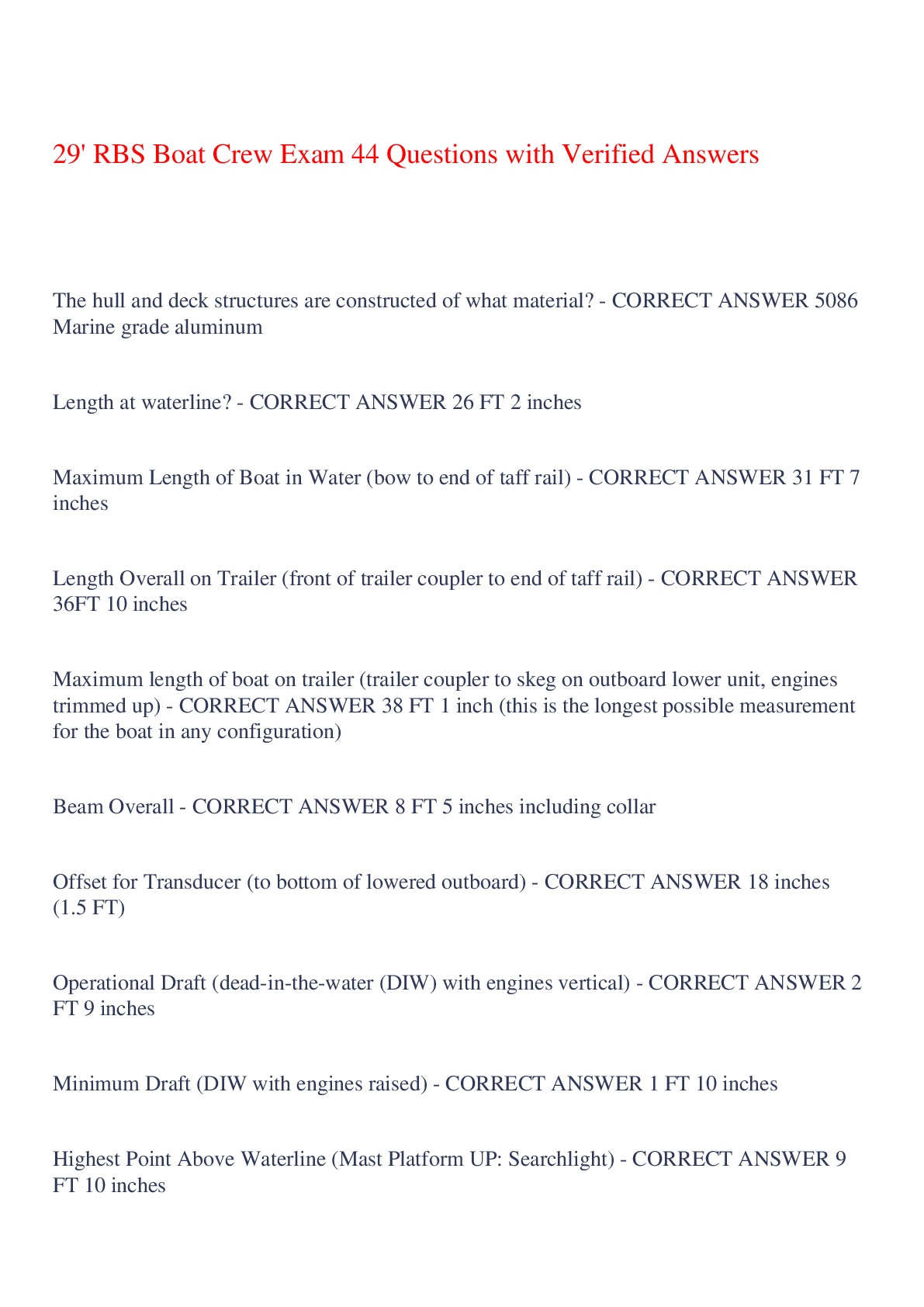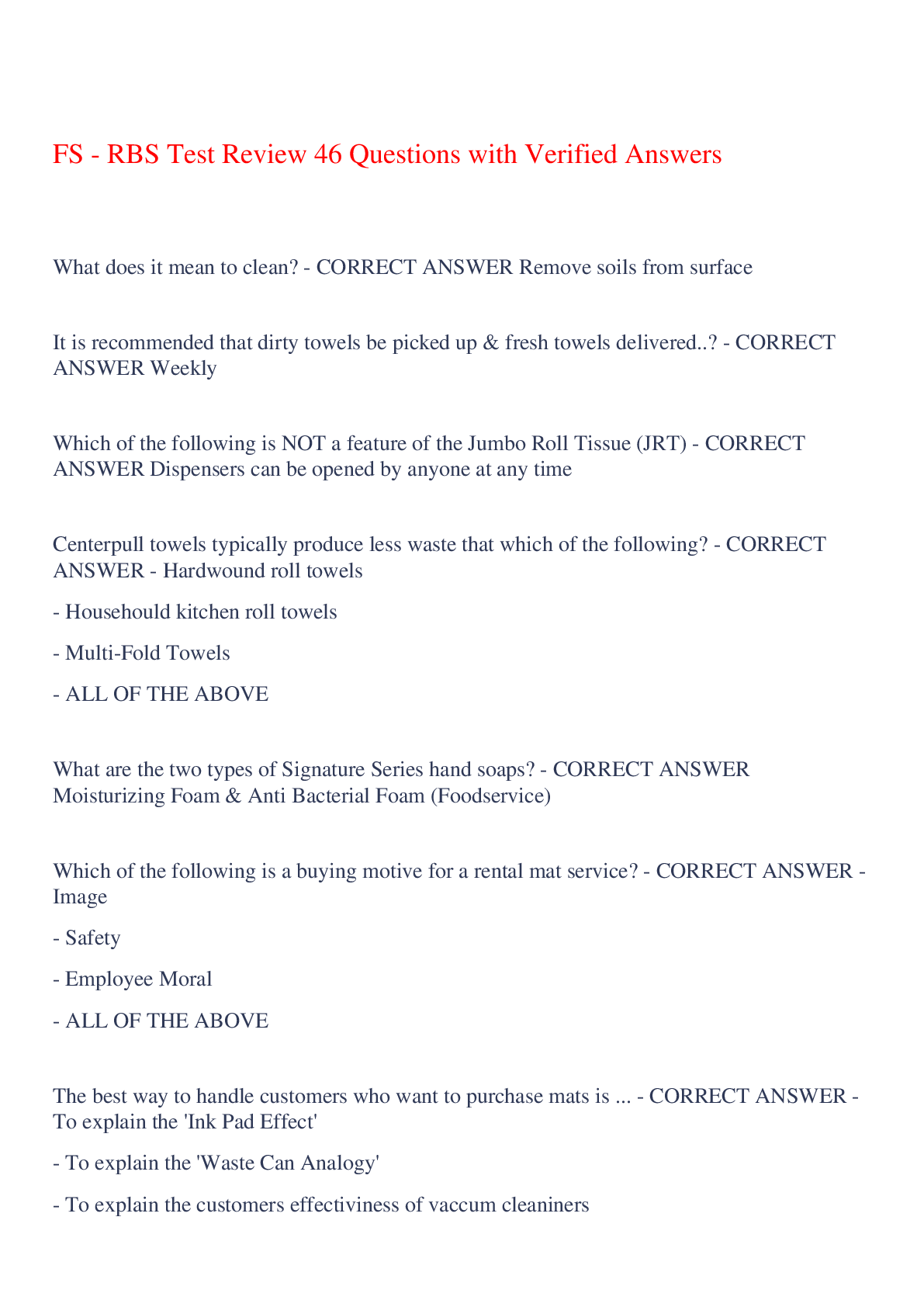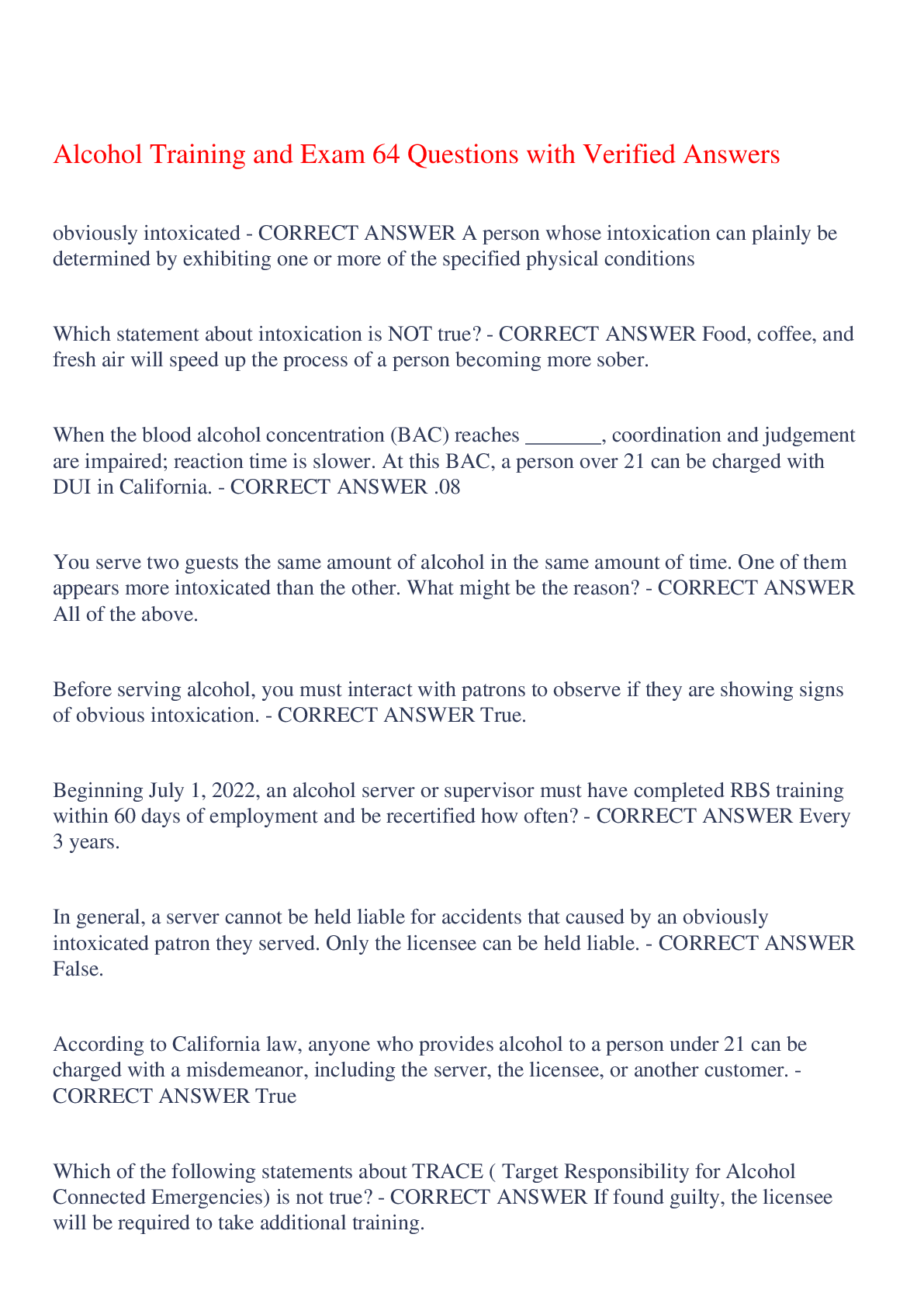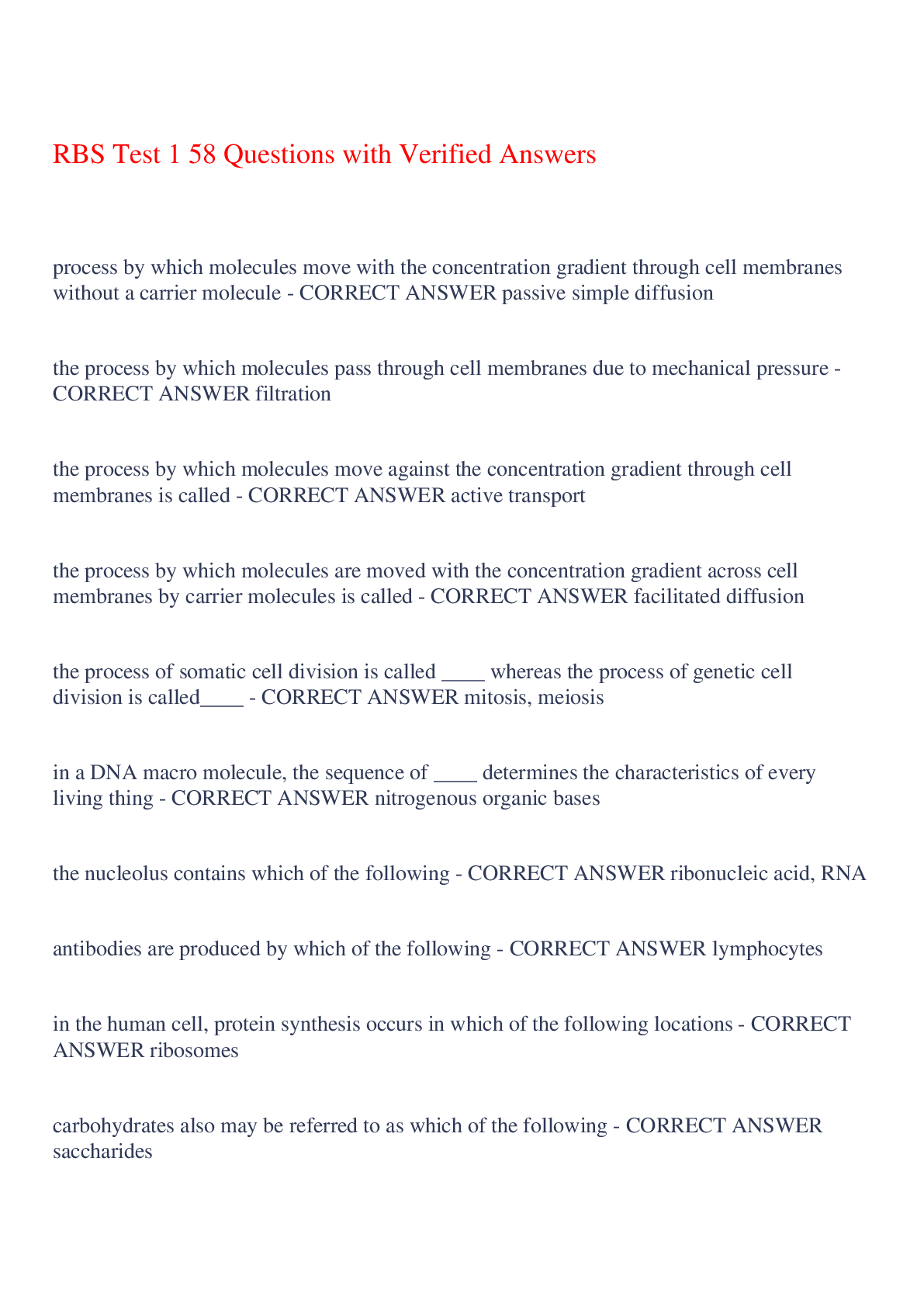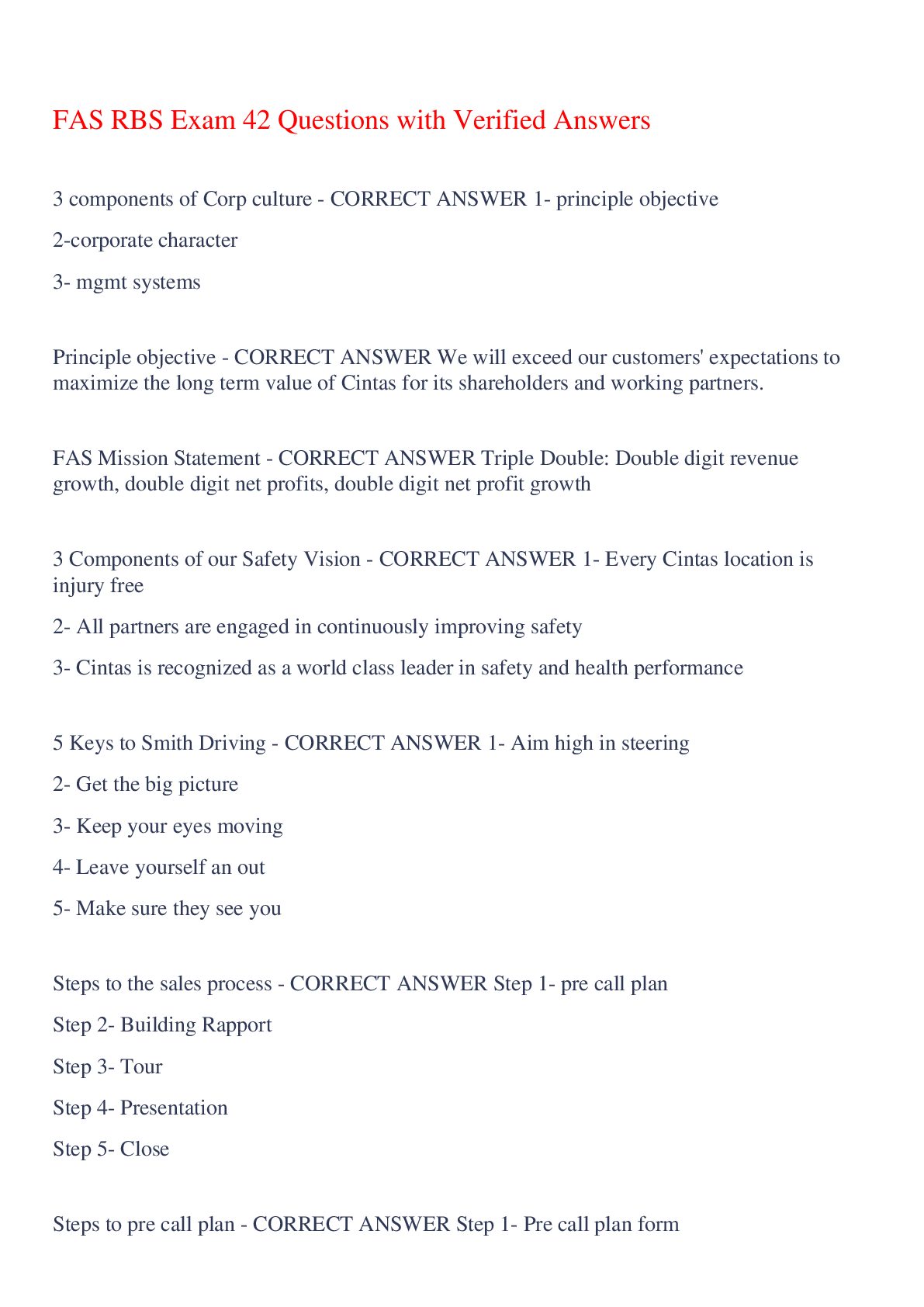CNRN Spine Exam 42 Questions with Verified Answers,100% CORRECT
Document Content and Description Below
CNRN Spine Exam 42 Questions with Verified Answers C1 - CORRECT ANSWER -atlas -Responsible for 40% left to right motion of the head -45% of the nodding flex/ex motion Which areas of the spine ... are most vulnerable to injury? - CORRECT ANSWER Areas where a mobile segment transitions to an immobile area -Cervicothoracic junction -*Thoracolumbar transition cauda equina - CORRECT ANSWER -collection of nerve roots at the inferior end of the vertebral canal -Starts around L1 where spinal cord "ends" autonomic nervous system - CORRECT ANSWER Sympathetic -Thoarcolumbar -Fight or flight -Activated during stress (norepinephrine) -Increased HR, BP, RR -Decreased GI/GU Parasympathetic -craniocervical -Vagus (CNX): 75% (acetylcholine) Dermatome Review - CORRECT ANSWER C2: scalp C3: calvicle C4: shoulder C5: BICEP C6: THUMBS AND INDEX F C7: MIDDLE FINGER, TRICEP C8: PINKY FINGER T4: nipple T10: umbilicus T12: pubis L2: THIGH L4: MEDIAL LEG L5: LATERAL LEG S1: CALF Shoulder Movement - CORRECT ANSWER C5-C7 -Wall pushup or shoulder shrug -Look for assymetry and "winging" of the scapula Shoulder Adduction - CORRECT ANSWER C5,C6 -Resist upward motion of patients "chicken wing" Elbow flexion - CORRECT ANSWER Extension of elbow -C7-C8 -Push me away Pronator Drift - CORRECT ANSWER -Most sensitive indicator of upper extremity deficit -Suggests mild hemiparesis before strength deficit is noted -Elbows and wrists extended with eyes closed (20-30 seconds) -Palms up Wrist Flexion - CORRECT ANSWER -C7,C8 -Flex your wrist and don't let me straighten it Wrist Extension - CORRECT ANSWER -C6-7 -Straighten your wrist and don't let me bend it Finger Extension - CORRECT ANSWER C7 Straighten your fingers and don't let me curl them Finger flexion - CORRECT ANSWER C8-T1 Curl your fingers and don't let me open them Finger Abduction - CORRECT ANSWER T1 Span your fingers out and don't let me push them together Finger Adduction - CORRECT ANSWER C8-T1 Don't let me separate your fingers Thumb Oppostion - CORRECT ANSWER C8-T1 Touch your thumb to your pinky and dont let me separate them Assessing Hip Flexion - CORRECT ANSWER Iliopsoas -L1,L2,L3 -Pick your knee up and don't let me push it down Hip Extension - CORRECT ANSWER L5, S1-2 I'm going to lift your leg, push down against me Hip Abduction - CORRECT ANSWER -Gluteus Medius -L4,L5,S1 Don't let me push your legs together Knee extension - CORRECT ANSWER -Quads -L2,L3,L4 -Bend knee with one hand on quads to palpate for contraction, other hand above ankle for resistance. Instruct pt to kick forward against your resistance Knee Flexion - CORRECT ANSWER -Hamstrings -L5,S1,S2 -Bend your knee against me Ankle Plantarflexion - CORRECT ANSWER -Tibialis Anterior, peroneus Tertius, extensor digitorum longus, extensor hallucis longus -L4,L5 -Point your toes up Foot Inversion - CORRECT ANSWER -Tibialis Posterior -L4,L5 -Roll the bottom of your foot inward against my resistance -Plantar surface faces into midline Foot Eversion - CORRECT ANSWER -Peroneus longus and brevis -S1 -Roll the bottom of your foot outward against my resistance -Plantar surface faces away from midline Spinal Nerve Reflexes: Components of a reflex arc - CORRECT ANSWER -Receptor -Afferent neuron -Interneuron ("connecting neuron" within the CNS) -Efferent neuron -Effector (the organ) DTR - CORRECT ANSWER -Deep tendon reflex -Muscle stretch -Contraction resulting from stretch in neuromuscular spindle in a muscle group, elicited by striking the tendon Cutaneous Reflex - CORRECT ANSWER -AKA superficial -Skin or mucous membrane is stimulated, resulting in a specific response in a muscle or muscle group -Ex: withdrawal flexor reflex to noxious stimuli to a finger -Superficial abdominal reflex, contraction in response to light rapid stroking on the skin of the abdomen Pathologic - CORRECT ANSWER -Reflexes that should not be present given appropriate developmental stage. Indicated interfered CNS function -Ex: Babinski reflex, return of primitive reflexes (grasp, sucking, rooting) Innervation of breathing - CORRECT ANSWER -C3 or above: paralysis of respiratory muscles, emergency intervention, intubation -C3-C5: Without the intercostals, there is no organized way to breathe- paradoxical breathing (decreased lung volume, risk of tire from work of breathing) Muscles of Respiration - CORRECT ANSWER -C2-C8: Rib cage accessory muscles -C3-C5: Diaphragm -T1-T7: Intercostals for deep breathing -T6-T12: Abdominal muscles for expiration and COUGH Artery of AdamKiewicz - CORRECT ANSWER Supplies the lower 2/3 of the spinal cord via the anterior spinal artery Vertebral Arteries - CORRECT ANSWER -Cervical vertebra 1-6 contain transverse foramen for vertebral artery intervertebral discs - CORRECT ANSWER Fibrocartilaginous -cushions movement -Central core: nucleus propulsus -Fibrous capsule: annulus fibrosus -Aging and trauma: Discs lose water content/injure Myelopathy - CORRECT ANSWER Cord compression Radiculopathy - CORRECT ANSWER Nerve root compression Spondylosis - CORRECT ANSWER Degenerative Stenosis - CORRECT ANSWER Narrowing spondylolisthesis - CORRECT ANSWER forward slipping of one vertebra over another. Most common at L4-L5 and L5-S1 Sagittal Balance - CORRECT ANSWER Front to back balance of the spinal cord based on an "ideal" set of angles Vertebroplasty - CORRECT ANSWER A minimally invasive technique that introduces cement into the inside of a collapsed vertebra to stabilize the fracture and reduce pain. Performed under fluoroscopy Dorsal Column - CORRECT ANSWER Fasciculi ascend -Proprioception -Vibration -Pressure -touch -visceral/organ pain Ventral column - CORRECT ANSWER Ascending fibers -Spinothalamic tract -Temp -Pain -Touch -Deep pressure [Show More]
Last updated: 1 year ago
Preview 1 out of 7 pages
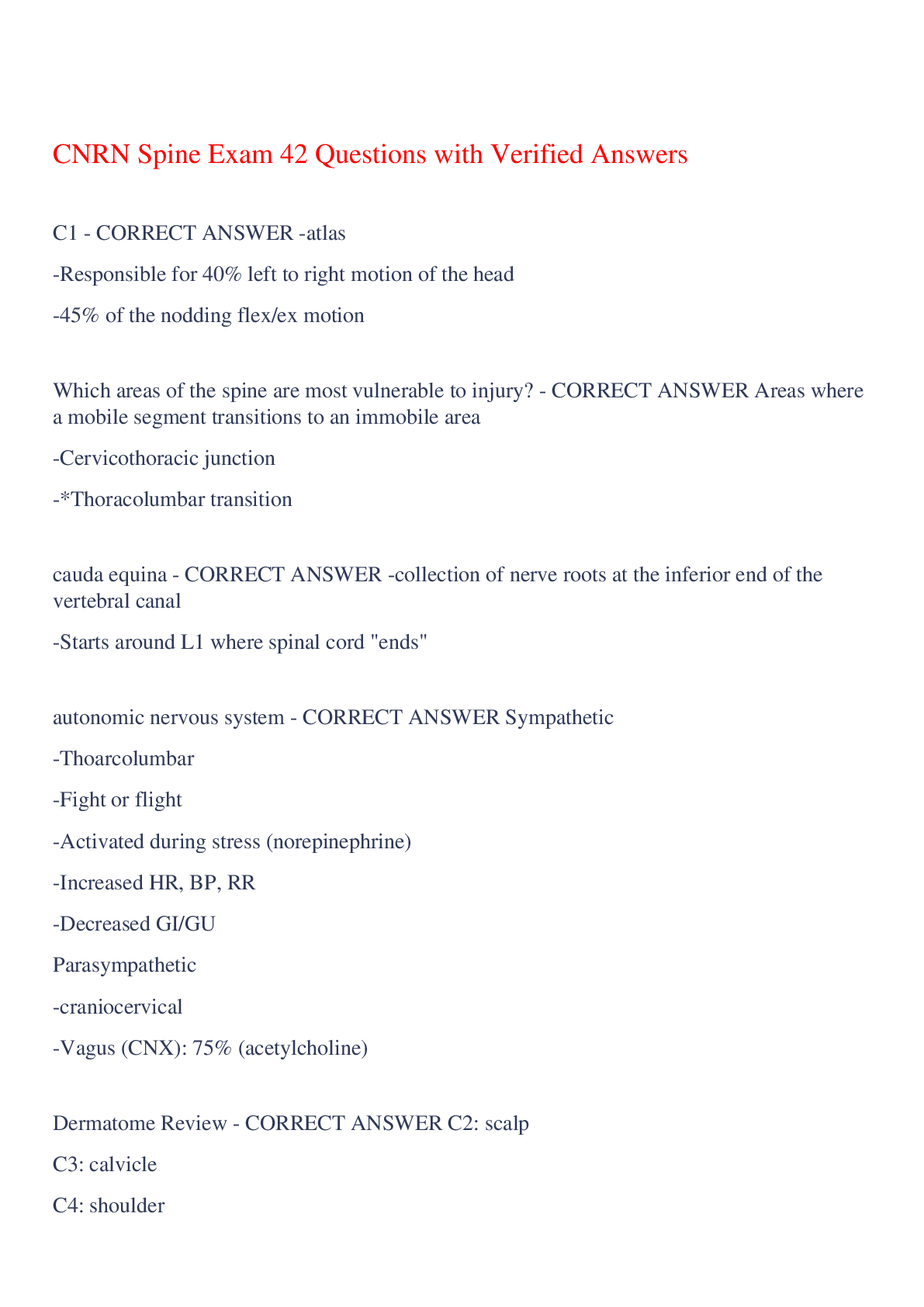
Buy this document to get the full access instantly
Instant Download Access after purchase
Buy NowInstant download
We Accept:

Reviews( 0 )
$8.50
Can't find what you want? Try our AI powered Search
Document information
Connected school, study & course
About the document
Uploaded On
Oct 24, 2023
Number of pages
7
Written in
Additional information
This document has been written for:
Uploaded
Oct 24, 2023
Downloads
0
Views
89



